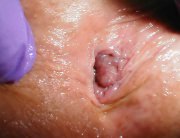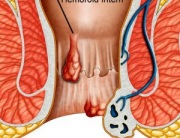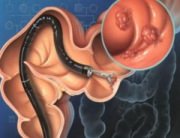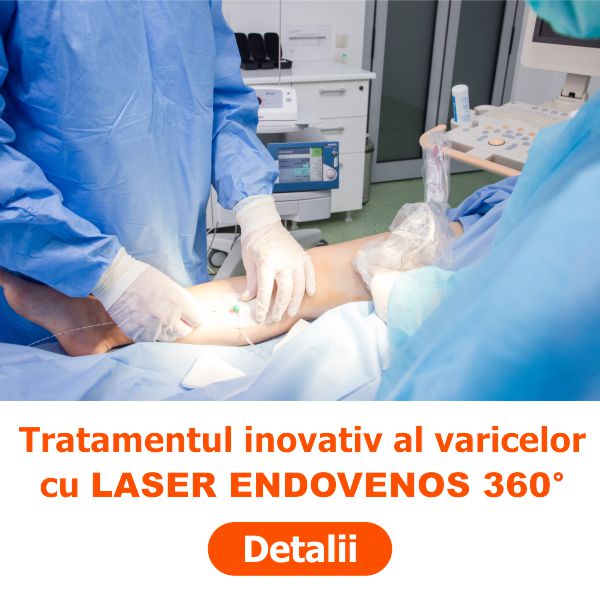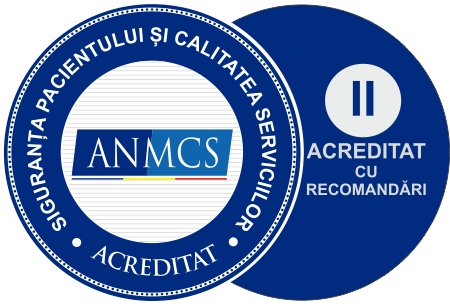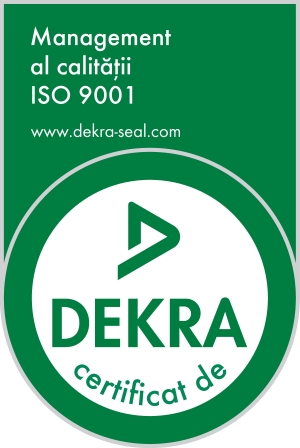 Rubber-Band Ligation of Haemorrhoids with rubber-bands is a procedure through which the basis of the haemorrhoid is ligated with rubber rings, this interrupting the blood flow towards the haemorrhoid. In order to perform this procedure, the physicians inserts an optical instrument (anoscope) into the anus. The haemorrhoid is pinched with a special instrument, and a device fits the rubber ring over the basis of the haemorrhoid. The haemorrhoid atrophies and falls off in approximately one week. A scar forms at the initial haemorrhoid site, so that the adjacent veins do not swell onto the anal canal.
Rubber-Band Ligation of Haemorrhoids with rubber-bands is a procedure through which the basis of the haemorrhoid is ligated with rubber rings, this interrupting the blood flow towards the haemorrhoid. In order to perform this procedure, the physicians inserts an optical instrument (anoscope) into the anus. The haemorrhoid is pinched with a special instrument, and a device fits the rubber ring over the basis of the haemorrhoid. The haemorrhoid atrophies and falls off in approximately one week. A scar forms at the initial haemorrhoid site, so that the adjacent veins do not swell onto the anal canal.
The procedure is performed in a medical clinic. You will be asked whether the rubber bands are too tight. If the ligature causes pain, an anaesthetic can be injected into the haemorrhoid. After the procedure, you may feel pain and a fullness sensation in the lower abdomen or a fake defecation sensation. The treatment is limited to 1-2 haemorrhoids per sessions, if the procedure is performed in a medical practice. A larger number of haemorrhoids may be treated during the same session if the patient is under general anesthesia. The other haemorrhoidal areas will be treated after 4-6 weeks.
What To Expect After The Treatment:
Patients respond differently to this procedure. Some are able to resume their daily activities almost immediately (with the recommendation to avoid heavy lifting). Other may require 2-3 days of rest.
- The pain is a common syndrome 24-48 hours after the ligation. You can use acetaminophen (e.g., Tylenol) and warm sitz baths to relieve discomfort.
- In order to reduce the bleeding risk, avoid aspirin or other nonsteroidal anti-inflammatory drugs (NSAIDs) for 4-5 days before and after the ligation.
- Bleeding may persist for 7-10 days after the procedure, when the haemorrhoid falls off. The bleeding generally is light and tends to disappear by itself.
Physicians recommend the use of fibre-content laxatives and liquid intake in order to facilitate defecation. The pressure during defecation may cause haemorrhoid relapse.
The Importance of This Type of Treatment:
Rubber-band ligation is widely used in the treatment of internal haemorrhoids. If the symptoms persist after 3-4 treatment sessions, surgical intervention might be required. Rubber-band ligation cannot be used if the removal device is unable to grasp (vacuum, pull) a sufficient quantity of tissue. This technique is almost never recommended for IV degree haemorrhoids.
Treatment Efficiency:
Rubber-band ligation is efficient in 7-9 out of 10 people opting for this technique. It is much less probable for the people opting for this treatment to require another technique, as compared to those using a coagulation treatment. Approximately 1 out of 10 people will require surgery.
Risks:
Though rare, secondary effects may include:
- ● Severe pain that does not respond to the post-procedural painkilling methods. The rubber bands may be placed close to the anal canal area hosting the pain sensory receptors;
- ● Anal bleeding;
- ● Urinary retention;
- ● Anal infection;
Remarks:
Rubber-band ligation is regarded as the most effective non-surgical long-term internal haemorrhoid treatment method. As this treatment may cause pain, some people may refrain from it. Even though other treatment methods may be less painful, they might not be as efficient, and a less efficient treatment might need to be resumed in the case of a relapse.
Haemorrhoidectomy can provide better long-term results than the fixative procedures, such as rubber-band ligation. However, the intervention is more expensive, requires a longer recovery time and has a higher associated risk of complications.



